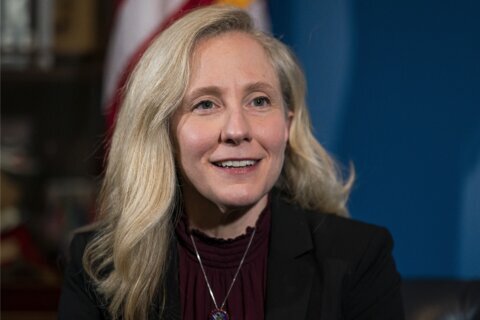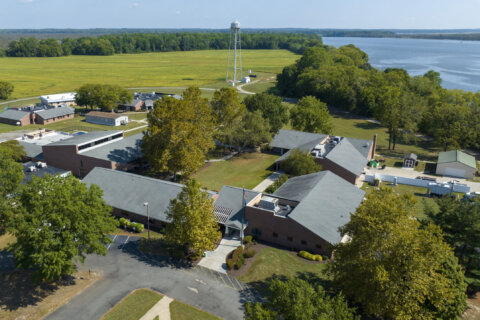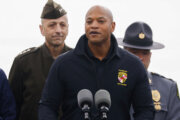This article was republished with permission from WTOP’s news partner InsideNoVa.com. Sign up for InsideNoVa.com’s free email subscription today.
This article was written by WTOP’s news partner InsideNoVa.com and republished with permission. Sign up for InsideNoVa.com’s free email subscription today.
The Congressional Naming Commission, in a virtual news conference Tuesday, announced the suggested new names of nine Army installations across the country, including three in Virginia.
The name suggestions will now be forwarded to Secretary of Defense Lloyd Austin for approval.
The three bases in Virginia are Fort Lee south of Richmond, Fort A.P. Hill in Caroline County and Fort Pickett in Blackstone, all of which were named to commemorate figures that fought in the Confederacy during the Civil War.
The commission provided the following biographies behind the suggested names:
Fort Lee’s suggested new name is Fort Gregg-Adams, which honors two different African-American Soldiers, Lt. Gen. Arthur Gregg and Lt. Col. Charity Adams, who played key roles in Army sustainment.
Like many Americans in the 1940s, Charity Adams started her service in response to the attack on America and the threats caused by global war. Born and raised in a segregated society, by the time the war began, the 22-year-old Adams had already graduated high school as valedictorian, completed a bachelor’s degree, and started a career as a teacher. In the middle of pursuing a master’s degree in psychology in 1942, Adams paused her education to serve her nation in the newly created Women’s Army Auxiliary Corps, according to the biography provided by the commission.
In 1944, at the age of 25, Adams was selected to command the first unit of African-American women to serve overseas. Leading the 6888th Central Postal Directory in England, Adams’ unit was tasked with delivering mail to and from almost 7 million soldiers fighting in Europe. Adams’ unit was the lifeline for soldiers’ morale, sorting and sending along the tens of millions of love letters, messages from family, and news from home that sustained soldiers’ spirits as they fought.
As Lt. Col. Charity Adams prepared to depart the Army in 1945, Arthur Gregg prepared to enter it. Seventeen years old, frustrated by segregation, and inspired by the service of African-Americans in World War II, Gregg enlisted in 1945. He quickly became involved in supply logistics in occupied Germany. As he helped the Army establish and rebuild the devastated region, Gregg excelled in the work and envisioned his rise within it. He applied to OCS in 1948, the same year President Truman ordered the desegregation of the armed forces. As a result, it fell to soldiers and officers like Gregg to put this policy into practice by changing the culture in their commands and desegregating the Army from the ground up.
Gregg did so with great skill, leading by example and embarking on a career of excellence from the moment he graduated OCS. Gregg ran a supply depot in Japan, commanded a supply and support battalion in Vietnam, and served in several assignments in Germany throughout the Cold War, including his leadership of the Army and Air Force Exchange System. At the peak of his service, Gregg served as logistics director for the Joint Chiefs of Staff, and as Deputy Chief of Staff for Logistics for the Army. In addition to his extensive service throughout the world, Gregg also promoted equality at home. As a young officer in the 1950s, Gregg also personally desegregated the Fort Lee Officers Club, and, throughout his career, he mentored numerous younger soldiers. When the Army established an award for logistics innovation and excellence in 2016, its namesake – and first recipient – was Lt. Gen. Arthur J. Gregg.
Fort A.P. Hill’s suggested name is Fort Walker, in commemoration of Dr. Mary Edwards Walker.
When Civil War engulfed the United States, Dr. Mary Edwards Walker knew exactly where she belonged. Born to a family favoring equality and already a successful surgeon, she never doubted that – as a skilled medical expert and American patriot – she should serve on the front lines of battle, working to save the soldiers who were fighting to save the nation.
Walker embarked on a career in medicine, earning her medical degree at the age of 22 from Syracuse University and beginning a career in private practice. By the start of the Civil War, the 28-year-old had already emerged as a skilled surgeon and strong abolitionist and advocate of women’s rights and equality.
During the early years of the war, Walker attempted several times to serve as a surgeon for the United States. Facing discrimination due to her sex, and refusing to work as a nurse because of her qualifications, Walker instead chose to support the United States as a volunteer. Early in the war, she worked for free, treating patients in the temporary hospitals set up around Washington, D.C. She also organized the Women’s Relief Organization, a group that facilitated and supported visits by family members to wounded soldiers. As the war moved southward into Virginia in 1862, Mary Walker did as well, treating wounded soldiers in field hospitals near the front lines after the carnage at Fredericksburg.
After repeatedly demonstrating her skill, service and dedication, she earned the esteem of some within the Army. After transferring to the Western Theater of the war, she was officially hired by General George Thomas in 1863, becoming the first female surgeon in Army history, contracted at a salary commensurate to a captain’s pay. Attached to an Ohio regiment in the Army of the Cumberland, she became known for her compassion as well as her skill.
In the contested borders of Tennessee and Kentucky, she frequently crossed lines to treat the sick and wounded regardless of affiliation. Indeed, it was on one such occasion in 1864 – when Walker stayed behind to treat wounded soldiers after the main army had moved on – that Confederates arrested her as a spy and imprisoned her in Richmond for four months. Freed via a prisoner exchange, Dr. Walker continued to serve, spending the final months of the war caring for women and orphans impacted by the destruction of war.
After a rejected promotion at the end of the war, Gen. William Sherman petitioned that she receive the Medal of Honor, and the president readily agreed. agreed. In November 1865, Walker received the Medal of Honor so that “an honorable recognition of her services and sufferings should be made,” and she spent the next 50 years campaigning for women’s equality, proudly wearing her Medal of Honor.
Fort Picket’s suggested name is Fort Barfoot, in commemoration of Tech Sgt. Van Barfoot.
Like approximately 15 million of his fellow Americans, Van T. Barfoot answered the call for national service during World War II. He started his service earlier than many, enlisting into the Army in 1940 as the nation mobilized in response to war in Europe and Asia. Barfoot watched with his fellow Americans as the war intensified, and he shipped out with his fellow soldiers after the attack at Pearl Harbor. He fought with great valor, evincing tactical skill, commitment to his mission, and dedication to his men.
These qualities became evident by his actions in May 1944. As a technical sergeant fighting in Northern Italy, Barfoot and his unit were assaulting well-entrenched German forces. When they came under ttack from machine gun positions in the foothills of the Alps, Barfoot moved out alone, heading for the enemy flank. Crawling to the edge of the first machine gun emplacement, Barfoot threw a grenade that killed two and wounded three of the crew, disabling the position. Securing the three prisoners, Barfoot advanced on a second machine gun nest which he attacked with machine-gun fire, killing two more enemy soldiers and taking another three prisoner. Continuing his solitary assault, Barfoot encountered a third machine gun emplacement and compelled the crew to surrender. Having turned the tide in the area, he continued to “mop up” the remaining enemy positions, ultimately taking 17 prisoners while consolidating the newly won position.
But Barfoot’s day was only half over.
Later in the afternoon the Germans counterattacked, with three tanks leading their charge. Now leading a small squad defending the ground gained, Barfoot acquired a bazooka and again moved out ahead of his men, facing the tanks alone. He fired on the lead tank, disabling it and causing the other two to turn away. When the crew exited the stopped vehicle, Barfoot attacked, killing three. With the counterattack reversed, Barfoot then proceeded further into enemy territory. Finding a field artillery piece that had been temporarily abandoned, he destroyed it by placing and detonating an explosive charge in its barrel. Finally withdrawing from these varied fights to the safety of his lines, Tech. Sgt. Barfoot discovered two grievously wounded American soldiers unable to evacuate by themselves. Risking his safety once again, he supported both as they moved almost a mile across exposed grounds, leading them to treatment and safety.
During the announcement, retired Navy Admiral Michelle J. Howard, commission chair, was not able to attend the event, but in a statement on the commission’s website said that the Naming Commission sought to find names that would be inspirational to the Soldiers and civilians who serve on our Army posts, and to the communities who support them.
“We realized that we had more heroes than we did bases to name. And we were overwhelmed with the greatness of the American Soldier – from those who gave their entire adult lives to the Army, to those who sacrificed themselves in valorous acts. We were reminded that courage has no boundaries by man-made categories of race, color, gender, religion or creed,” Howard wrote.
“Our goal was to inspire today’s Soldiers and the local communities with names or values that have meaning,” she added. “We wanted names and values that underpin the core responsibility of the military, to defend the Constitution of the United States. We wanted names and values that evoke confidence in all who serve. Confidence that, by emulating those whose names are on the installations, we too can rise to every challenge, overcome every obstacle, achieve excellence, and, if necessary, sacrifice our lives for this country and her people. These names we are recommending embody the best of the United States Army and America.”
The list of suggested names will be presented to House and Senate Armed Services Committees, and then to Secretary Austin, who has the authority to change the names, expected to take place in the fall of 2024.







